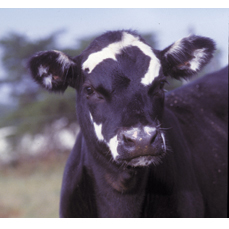


by Judy Bolyard Purdy
Intro
| Tangible
results | Cows, cows & more
cows
|
Genetic
preservation | Pig
Tales
| The
war against disease

Cows, cows & more cows
Cloning won’t replace sexual reproduction of livestock, but it offers a faster way to improve livestock genetics, and that could be a big plus for cattle producers and beef consumers, Benyshek said. Cloning also could improve the genetic diversity of a breed, offering more options for future generations. “A prized bull or cow has a limited lifespan, but its genes can be stored indefinitely under lab conditions,” he said.
Stice’s cloning technique — a subtle but significant tweaking of the one that spawned Dolly — increases cattle cloning efficiency three-fold. That’s a significant improvement over Ian Wilmut’s, who cloned Dolly on his 277th attempt. Until Stice’s recent improvements, most scientists were averaging a 5 percent suc-cess rate. While Stice’s technique, which succeeds in one of every seven attempts, isn’t efficient enough to put cloning in mainstream breeding options, cloning has other qualities to recommend it.
“Presently it takes six to nine years to move the best animal genetics to the marketplace,” he said. “With cloning we can have animals ready for the marketplace in two to three years and they also will be uniform quality.”
Eight frisky Angus calves — the first fruits of the UGA-ProLinia research to improve cloning efficiency — were born between February and April 2001. By fall, they were grazing in the green pastures of a Midwestern farm. The calves were cloned from adult cells of a prized cow beyond her breeding years.
Because their genetic make-up is identical to the prized cow from which they were cloned, “genetically, the calves have a higher value to the beef industry than other calves,” Stice said.
The calves are now part of a breeding herd, but earlier this year one of the original eight clones died from heart problems. “Cloned animals have more problems and we don’t know if hers was related to cloning or not,” Stice said.
The UGA-ProLinia collaboration achieved another cloning feat this past April by cloning the first calf from cells of a slaughtered cow. KC, an Angus-Hereford cross named for the kidney cells from which she was cloned, demonstrates that the cloning process can be applied to cattle after they’ve been slaughtered and their meat graded.
“From
an agricultural view, it’s very important to be able to clone cells
from an animal that has gone through all the testing for meat quality
and tenderness,” Stice said.
KC has tremendous implications for the livestock industry, especially
since she was cloned from a cow that was slaughtered according to normal
meat processing protocols, said ProLinia President Mike Wanner.
“We didn’t want to disrupt the process or change the methods slaughterhouses use in processing the meat. We didn’t want to add any additional steps,” Wanner said. “This would be a natural and easy way to access the tissue.

The birth of KC — cloned from kidney cells harvested from a 48-hour-old carcass — shows cloning’s potential for the beef industry.

“The intent is to wait until the meat is graded, select those with preferred grading characteristics and bring those genetics back into a breeding program,” he said.
While KC is not the first clone from a dead animal — Italian scientists cloned a wild mouflon sheep in 2000 from cells of a sheep that had died — she is “definitely the first calf cloned from a 48-hour-old carcass,” Stice said.
Her birth signals potential benefits for both producers and consumers. The cloning technique that produced KC could mean, at the retail counter, tastier, higher quality, more consistent steaks. For beef breeders, it’s a harbinger of healthier, genetically uniform herds that produce reliable cuts of meat.
The next goal is to improve the pregnancy rate, Stice said.
“We’ve been able to get the best success rates we know of for cloning cattle, but inefficiency of the cloning process is still the single, largest problem,” he said. “In the next five years we hope cloning will produce thousands of cloned cattle for agricultural production.”
At the moment, it doesn’t come cheap. “We need to bring in $20,000 per animal. At the current state of technology, it’s really paying for the research so that we can get to the next point where we can produce an animal for $5,000,” he said.
Through the UGA Research Foundation, Stice has applied to patent the tightly guarded secret technique. It is based on a chemical inhibitor that improves the survival rate of embryos during the first seven days of growth by synchronizing cell development during a critical phase of development. (See related flow chart ). Once patented, ProLinia will license the technology.
Stice is unequivocal about who owns the intellectual property from his research. “First and foremost I am a university professor and my loyalty lies with the University of Georgia,” he said. “At the same time I think there is an opportunity for professors to be entrepreneurs. They are running their own shops, basically, and they have to be thinking, ‘How am I going to get the next grant to move my research forward?’”
From having worked in industry and from having a father who is a patent attorney, Stice has seen how conflicts of interest can arise.
“You have to be very conscious of those when you start down this path,” he said. “You have to be very open about things you’re doing. It only works if it’s a win-win situation for the university, for the professor and, of course, for the company.”
Intro
| Tangible results | Cows,
cows & more cows
|
Genetic preservation | Pig
Tales
| The war against disease
For comments or for information please e-mail the editor: jbp@ovpr.uga.edu
To contact the webmaster please email: ovprweb@uga.edu
![]()